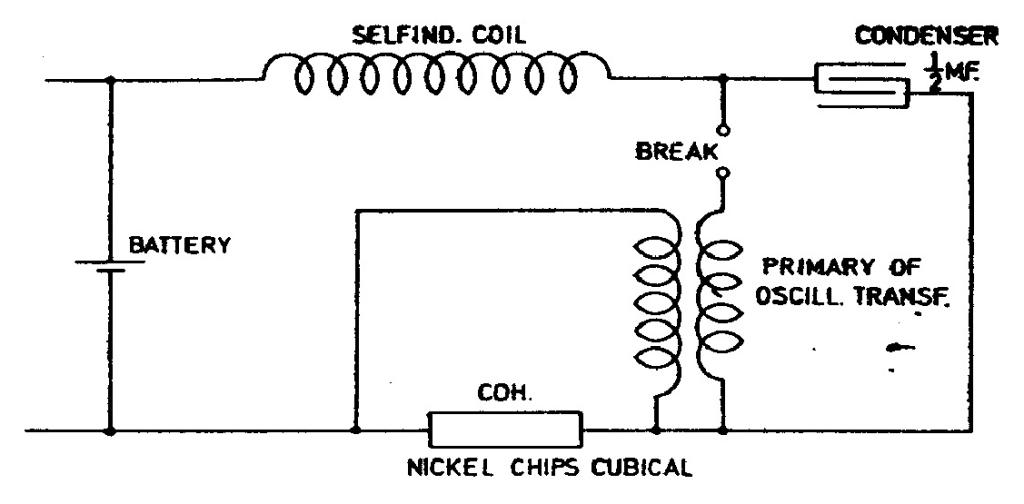
Nikola Tesla Books
Colorado Springs
July 12, 1899
Self-induction coil for condenser method in conjunction with oscillating transformer. Adapted to Thomas clockwork and condenser 1/2 mfd. mica on hand (one of the two small condensers). Capacity given 1/2 mfd., break also given: wheel of clockwork breaking and making contact has 180 teeth, turns about 20 a minute. This gives breaks $! {{180 \times 20} \over 60} $! = 60 per second. Here at each make and break we have a wave in the condenser, and tuning may be effected either by making n = 60 or n = 30.
Best result seemingly, from former experiments with oscillators, seems to make n = the number of breaks. We have then
$! {T = {{2 \pi \over 10^{3}} \sqrt{L \times {1 \over 2}}}} $!
$! {T = {{1 \over n} = {1 \over 60} = {2 \pi \over 10^{3}} \sqrt{L \times {1 \over 2}}}} $!
From this $! {L = {{2 \times 10^{3}} \over 144}} $! = 2000:144 = 14 H= 560
This would not be realizable with a condenser of $! {1 \over 2} $! mfd. Therefore a larger condenser or quicker break necessary - will vibration always take place through the high resistance of sensitive device? $! {{4L \over C} > R^{2}} $! Take L = 1 henry, we have $! {{4 \over 1} \over {2 \times 10^{6}}} > R^{2} $!, $! {8 \times 10^{6} > R^{2}} $! or roughly 3000 > R. This shows that although resistance may be very large, vibration will still take place.
Follow up.
84
July 12
Early on in the diary Tesla mentioned a method using a condenser to store energy from weak impulses arriving at a receiver. In the circuit drawn here, the condenser is charged by a battery via a self-inductance coil and a coherer shunted by the secondary of an oscillation transformer. In the absence of an external signal the resistance of the coherer is large so that the charging current is small. The circuit breaker periodically discharges the condenser through the primary of the transformer generating alternating current in the secondary which biases the coherer. When an external signal is received the resistance of the coherer is reduced and the charging current rises rapidly, which in turn increases the AC bias on the coherer which therefore soon gets to full conductivity (in fact there is a feedback loop).
July 12
In the beginning of the notes, Tesla mentions the capacitor methods which use a capacitor as energy accumulator for weak impulses which in certain intervals act on receiving systems for registration. The circuit shown in the figure consists of the capacitor which is charged from a battery wire from self-inductive coil and device a shunted by the oscillating transformer secondary. When there is no outside signal, the device resistance a is high and consequently the capacitor charging current is low. The breaker periodically discharges the capacitor across the oscillating transformer primary, and thus the alternating currents are produced which at the secondary terminals produce the device a pre-excitation. When an outside signal arrives, and device a reduces its resistance, the capacitor charging current quickly increases producing the higher additional voltage on device a, which very quickly leads to full conductance (there is therefore a return link).


